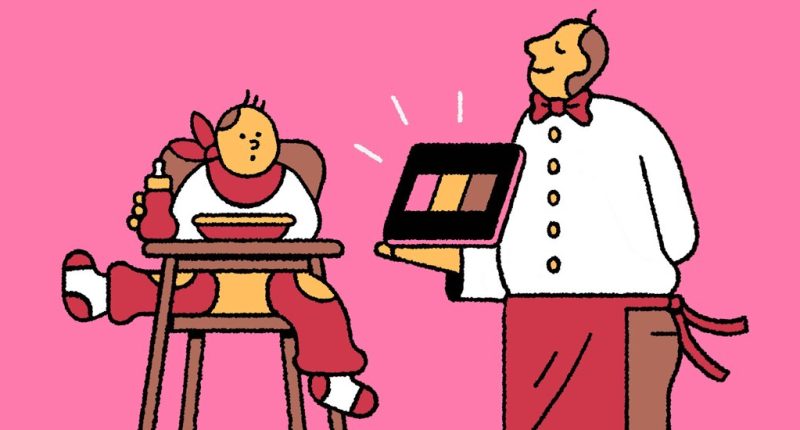
If you feel that you’re being asked to tip more often, you’re not alone.
Most American adults say tipping is expected in more places than it was five years ago, a recent survey from the Pew Research Center found. Once limited mainly to sit-down restaurants, hotel bellhop services and taxi rides, invitations to tip — with suggested amounts — now appear on checkout touch screens in more places, including casual restaurants without table service, mobile food trucks, delivery apps and even self-service kiosks.
“People used to feel there was a line,” said Ismail Karabas, an assistant professor of marketing at Murray State University in Kentucky who has studied tipping. “It’s a lot more blurred, and it throws people off. Where do we stop?”
A survey published in June by the financial website Bankrate found that two-thirds of Americans had a negative view of tipping, while about one-third felt that tipping culture was “out of control.”
Ted Rossman, a senior industry analyst at Bankrate, said that what was meant to be a gesture of gratitude, or a reward for good service, felt increasingly like a surcharge. “The constant asks are rubbing people the wrong way,” he said.
Mr. Rossman recalled encountering a tip screen this year at a self-checkout station at Newark Liberty International Airport. He was also taken aback when asked to tip at a pick-your-own strawberry farm. (He did, he said, because his wife was in favor of doing so.)
“It’s becoming more of the exception not to be asked to tip,” he said.
Replacing the old-fashioned tip jar, new digital payment systems have made it easy for businesses to ask customers for tips electronically.
Michael Lynn, a professor of services marketing at Cornell University who has studied tipping, said people often leave gratuities for social approval, from the service provider or from fellow customers. So for some, it can feel awkward to tap “other amount” or “no tip” on a payment screen if they feel that the employee or others in line are watching. Under those circumstances, he said, people can feel coerced to tip, or guilty if they opt out.
More generous tipping practices took hold earlier in the coronavirus pandemic, with people inspired to help frontline workers. But as the pandemic eased, higher inflation took hold, and tipping as a percentage of a pricier meal tab became more noticeable. The Bankrate survey found a general decline in the share of people who said they always tipped in certain situations, including for food delivery.
There does, however, seem to be some consensus around when tipping is appropriate, the Pew survey found, notably at sit-down restaurants (92 percent of respondents said they “always” or “often” tipped there).
That’s not surprising since tipping at full-service restaurants is an ingrained habit, Professor Karabas said: “People expect it. It’s an inherent part of the system.” In many states, the minimum wage for tipped employees is quite low, he said, and it’s generally understood that the servers “are working for tips,” so leaving a tip of at least 16 to 18 percent of the tab is justified.
But diners aren’t necessarily being extravagant with tips these days, the Pew survey found. Asked how much they would tip for an “average” sit-down dining experience, the majority (57 percent) said they would tip 15 percent or less. Two percent said they would leave nothing. Just a quarter said they would tip 20 percent or more.
The Pew survey found significant support for tipping after a haircut (78 percent), a food delivery (76 percent), buying a drink at a bar (70 percent) and using a taxi or ride-hailing service (61 percent).
Tipping is less common in other situations, however, including when buying a drink at a coffee shop. Only about a quarter of people said they usually tipped in that situation. And the percentage was even lower (12 percent) for fast-casual restaurants.
Yanely Espinal, director of educational outreach for Next Gen Personal Finance, which creates financial literacy courses for students in middle and high school, said context was important. It’s OK not to tip, or to leave a small tip, when running into a shop for a quick cup of coffee or tea to go, she said. But if it’s a shop you frequent often or you order a complicated drink, you might consider leaving one.
“Use your judgment about when it makes sense,” she said.
Overall, Pew’s survey found, 43 percent of adults said they had worked in a job in which they received tips, and they were usually more likely to leave a tip.
Professor Karabas suggests thinking about what you will do ahead of time. “Expect that you might be asked to tip and decide what you want to do, based on your own personal feelings and budget,” he said.
As for how much to tip, check out the online guide at the Emily Post Institute, an etiquette firm in Waterbury, Vt., run by descendants of the manners maven Emily Post. Sample suggestions: While there’s no obligation to tip for takeout food that you pick up yourself, a 10 percent tip is appropriate for curbside pickup or for a large, complicated order. And for food delivery, aim for 10 to 15 percent of the bill — but $2 to $5 for pizza, depending on the size of the order and the difficulty of delivery.
Here are some questions and answers about tipping:
I don’t like feeling pressured to tip at checkout. What can I do?
Gratuities remain voluntary, with the arguable exception of sit-down dining because tips can be a big part of the server’s income, said Lizzie Post, a co-president of the Emily Post Institute. Should you receive subpar service at a sit-down restaurant, she advised tipping at least 15 percent but then talking to the manager.
If suggested tips really bother you, Professor Lynn said, paying with cash instead of a debit or credit card can help you avoid them. If you’re prompted by a screen to tip in a nontraditional setting and you don’t feel that one is warranted, feel free to skip it.
“Do you need to feel guilty?” Professor Lynn asked. “I don’t.”
If I tip at a self-service kiosk, who gets the money?
This varies, Professor Karabas said. Some businesses may pool tips for groups of workers, while others designate tips for the employee overseeing the checkout area when the tip was entered. (For instance, he said, he recently visited a “robotic” coffee shop in Seattle where the worker tending the shop explained that employees received the tips generated during their shifts.)
Should I tip more during the holidays?
Holiday tipping is “sort of a different beast,” Ms. Post said. “It’s really about saying thank you to service providers in your life at the end of the year.” That might include hairdressers, dog walkers and housekeepers. If you can afford to be generous, by all means do, she said. But if your budget is tight, she suggested giving a card or a personal note, saying you regret that you can’t tip this year, but expressing your thanks.
Source: | This article originally belongs to Nytimes.com








